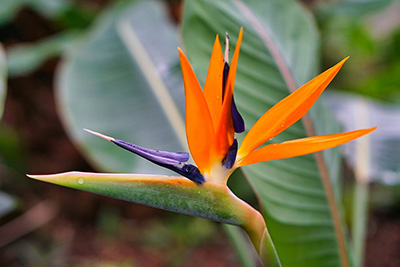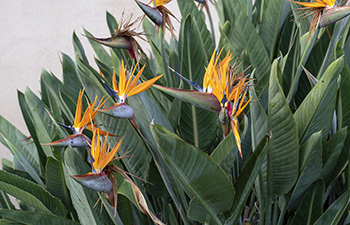Bird of Paradise

Bird of paradise is a striking evergreen plant with blue-green foliage and showy orange and blue blooms that resemble a bird in flight. Its drought tolerance and pest resistance make it a favorite low-maintenance tropical plant.
Characteristics
Strelitzia reginae thrives in USDA Hardiness Zones 10 through 11, although it can survive further north with frost protection. In North and Central Florida, containers are ideal because the plant can be brought inside when freezes are imminent.
It can be planted year-round in mass plantings, as a specimen, in a container, or as an accent plant. Bird of paradise reaches a maximum height of three to five feet with a spread of two to four feet. Mature plants will grow into clumps, which can be an attractive focal point in the landscape.
Leaves are oblong, 12 to 18 inches long, and held on long, stiff leafstalks. They are an attractive blue or blue-green color and remain that color all year. Blooms emerge periodically throughout the year and give the appearance of orange and blue birds taking flight from the plant. Technically, this “bloom” is comprised of sepals and bracts, but just like poinsettias, these bracts are typically called flowers. Mature plants can produce up to three dozen flower spikes annually, which can last two weeks when used as a cut flower.
Planting and Care

The ideal planting location will have fertile, well-drained soil that is high in organic matter. It should have partial shade with minimal salt (light spray is tolerated). Plants grown in part shade will grow taller and have larger flowers than those planted in full sun. If you are going for a dramatic landscape feature, space your plants about six feet apart to allow room for the flowers.
Plant bird of paradise in a groundcover or in front of a shrub border to highlight the blue tones in its foliage against the green shrubs. It is also ideal for planting next to pools and patios since it doesn’t tend to cause leaf litter.
Before planting, thoroughly water the potted plant. Then, dig a hole that is two or three times the diameter of the root ball and as deep as the root ball is tall. Next, gently remove the plant from the pot and place it in the hole. Fill in the hole with the removed dirt, lightly tamp it, then water thoroughly. Create a ring around the plant with the extra soil to create a basin. This will help contain water and route it to the plant’s roots.

If the soil is hard, compacted, or has poor drainage, plant your bird of paradise half as deep. Then, mound soil around the plant to completely envelope the root ball. It will likely require more frequent irrigation, but this method will help provide the drainage that the plant needs.
Your newly planted bird of paradise will need frequent rainfall or irrigation for six months to aid with establishment. Once established, frequent watering is only needed during the warm growing season. Irrigation is only necessary in the winter if the soil is dry.
Applying mulch around the plant is a great way to conserve moisture, moderate the soil temperature, and keep weeds at bay. Mulch options include leaves, pine needles, bark, wood chips, gravel, or crushed stone. Apply mulch in a layer two to three inches deep around the plant, keeping two to three inches bare around the base of the plant to prevent stem rot.
To attain prolific flowering, you should fertilize bird of paradise about every three months during the growing season according to label directions. Keep in mind that there may be fertilizer ordinances in your county that restrict the use of nitrogen and phosphorous fertilizers during certain months. You can use organic, granular landscape, or controlled-release fertilizers. Be sure to also remove any dead leaves or spent flower stalks to keep your plants looking neat and prevent fungal problems.
Eventually, your plant will grow into a mass as it puts out new shoots. You can easily propagate new plants through division. To do this, dig up and separate mature clumps in the late spring or early summer. Pull them apart into single stems, and then re-plant the stems at the same depth they were before. Irrigate the divisions to keep the soil moist for three months (until roots are established), and then begin fertilizing. In a year or two you will enjoy mature, flowering plants.
Major pest issues are rare, but you may encounter aphids, caterpillars, grasshoppers, scales, snails, and leaf borers. Also watch out for fungal leaf spot disease. If you have a pest or disease problem, reach out to your county Extension office.
White Bird of Paradise

White bird of paradise or giant bird of paradise (Strelitzia nicolai) is a relative that is larger and even more dramatic. The foliage resembles banana leaves and can shred in the wind. They grow in tall, clumping stalks that look quite exotic. Plants can achieve heights of 20 to 30 feet, with a spread of 10 feet. Older leaves will drop off as the plant grows, leaving the lower stalks bare. The flowers are white with a blue tongue and appear within the canopy.
White bird of paradise can grow in zones 9B through 11 and is cold sensitive. Only consider planting it if you can dedicate enough space to accommodate its massive mature size. It prefers a location that is in full sun to light shade, with moist, well-drained soil. Prune any dead leaves and excess growth at the base of the stalk, if desired. Propagation is easiest by division.
If you like the look of white bird of paradise but you don’t have a space wide enough for it, consider planting traveler’s tree (Ravenala madagascariensis) for a similar effect. This tree-like plant still gets very tall—up to 30 feet—but doesn’t spread in clumps like white bird of paradise.
To learn more about bird of paradise and other landscape plants, contact your county Extension office.
